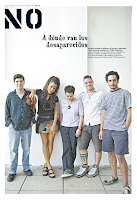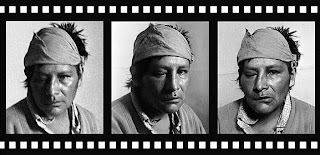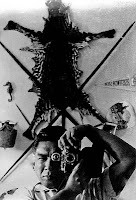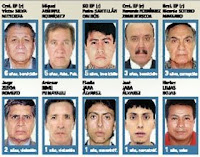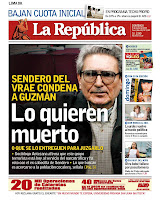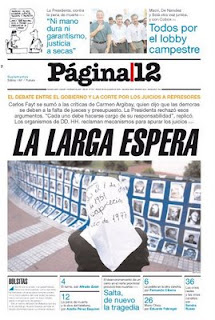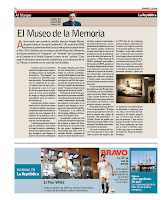There's nothing like starting the weekend with one of those articles that fill you with rage, and so it was this morning with IPS's article focusing on Peruvian army chief Otto Guibovich. He's complaining that soldiers being held to account for all the torturing and murdering they did during the conflict is affecting morale. Aaaaah.
Sarcasm aside, it's not an uncommon argument: the army was just doing its job, fighting bravely against a vicious and clandestine enemy, and now it's just
so unfair that the soldiers aren't receiving gratitude, but are being dragged through the courts by a bunch of lefty human rights activists who
don't understand what war is about. OK, I didn't manage to drop the sarcasm for long. This is one of those really pervasive theories (along with "Fujumori saved us from terrorism", "Pinochet may not have been very nice but at least he fixed the economy", and the "two devils" theory in Argentina) which deserve ripping apart, so let's do it.
According to Guibovich:
the armed forces cannot be accused of committing human rights violations as a habitual practice. "The margins of error in the counter-subversive war are very small – highly regrettable, but small," he said.
"These are very specific, limited cases. In order for justice to be effective it must be specific, and must avoid generalisations. In the army, we weren’t taught to gather up suspects in a room and throw in a grenade. We were not indoctrinated to kill, to rape, to torture. That is just not how things are," the general said.
According to the Truth and Reconciliation Commission:
The TRC affirms that at some places and moments in the conflict, the behavior of members of the armed forces not only involved some individual excesses by officers or soldiers, but also entailed generalized and/or systematic practices of human rights violations that constitute crimes against humanity as well as transgressions of the norms of International Humanitarian Law.
The TRC has established that the most serious human rights violations by military agents were: extrajudicial executions, forced disappearance of persons, torture, cruel, inhuman or degrading treatment. The TRC particularly condemns the extensive practice of sexual violence against women.
According to Guibovich:
"The work was extremely hard, but we had to do it. I have seen people under my command die. I have picked up dead soldiers, young men aged 18 or 20 who were doing their military service and defending democracy," he said.
"They were not killers: they were the sons of poor families, like the peasants massacred by Sendero Luminoso. But who is in the dock now? The military," said Guibovich.
The TRC devotes extensive space in its final report, and 21 separate points in its English-language summary, to pointing that the main responsibility for the conflict lies with the Shining Path. Let me say that again because human rights activists are sometimes accused of forgetting it (although I doubt they do): Sendero Luminoso initiated this period of violence in Peru. Sendero Luminoso showed disrespect for the democratic elections in 1980 which was the beginning of their 'armed struggle', and they were responsible for the majority of deaths. In addition, the TRC
recognizes the efforts and sacrifices made by members of the armed forces during the years of violence, and offers the most sincere homage to the more than one thousand brave agents of the military who lost their lives or were disabled in the line of duty.
But the army was not a terrorist organisation with the aim of bringing down the state. Its duty was to protect the people. Should it not have had higher moral standards than the Shining Path?!
The TRC notes that at the time of their intervention in the fight against subversion, the armed forces were prepared and equipped to engage in conventional conflict (external conflict). During the first years of their intervention (1983-85), they lacked adequate intelligence on the organization, military profile and strategy of the PCP-SL. By decision of civilian authority, their objective was to rapidly end the conflict without taking into account the cost in human lives. They set out to recover territorial control, assuming that the population was divided into communities loyal to the Peruvian State and subversive or red zone communities, without noting that the latter were not homogeneous and generally contained sectors dominated by the PCP-SL through coercion and even terror. In the TRC’s view, although the military intervention hit the organization and the operational capacity of the PCP-SL hard, it also left in its wake massive human rights violations and turned the two-year period from 1983-84 into the most lethal of the conflict, mostly in Ayacucho. Worse still, the strategy turned out to be counterproductive, as the indiscriminate repression in the rural areas postponed the rupture between the PCP-SL and the poorer sectors of the peasantry, and failed to stop the expansion of armed action to other areas of the country.
In a nutshell:
1) Shining Path initiated armed struggle.
2) The army responded at first inadequately, and then with an extremely heavy hand. Unaccustomed to internal warfare and indoctrinated with institutional racism, they treated all indigenous people as potential terrorists. The years 1983-84 in Ayacucho were particularly bloody, largely due to state-sponsored human rights abuses. In this way, the army treated the population it was supposed to protect with the utmost cruelty and contempt.
3) The army's later change in tactics to a slightly more conciliatory approach, combined with the disillusionment with the violence of the Shining Path, paid off.
4) The army was ultimately responsible for around one third of deaths in the conflict, the great majority of these innocent civilians, in some cases including minors. The army also suffered its own losses.
5) The army is not being prosecuted as an institution, trials affect individuals. Clearly, this may end up being a large number of individuals and may reveal institutional failings.
6) The TRC acknowledges both sides of the conflict and gives the lion's share of responsibility to the Shining Path. It has no interest in persecuting the armed forces, but reports the facts.
7) In recent months, the army has shown that its human rights training has still not paid off, since 47 cases of forced disappearance and other crimes have been reported.
Army Chief Complains that Trials Hurt "Morale" (IPS)
TRC General Conclusions (English-language summary)




